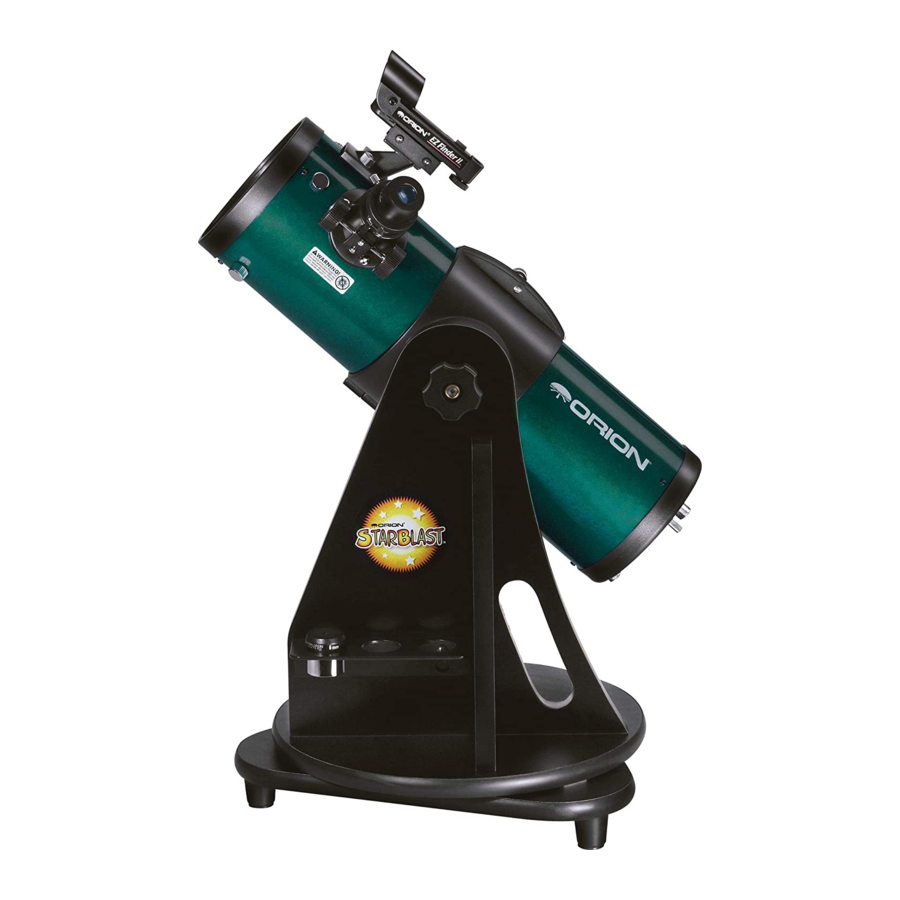
Orion StarBlast 4.5 Instruction Manual
4.5" telescope
Hide thumbs
Also See for StarBlast 4.5:
- User manual (20 pages) ,
- Instruction manual (19 pages) ,
- Instruction manual (17 pages)
Advertisement
Quick Links
Lynbrook Public Library
56 Eldert Street
Lynbrook, NY 11563
516-599-8630
Orion StarBlast 4.5" Telescope
INSTRUCTION MANUAL
June 2015
WARNING: Never look directly at the Sun through this telescope or its finder scope — even for
an instant — as permanent eye damage could result. Do not point the telescope at the Sun, as
parts will melt! Children should use this telescope only with adult supervision.
NEVER POINT THIS TELESCOPE AT THE SUN!
1
Advertisement

Subscribe to Our Youtube Channel
Summary of Contents for Orion StarBlast 4.5
- Page 1 Lynbrook Public Library 56 Eldert Street Lynbrook, NY 11563 516-599-8630 Orion StarBlast 4.5" Telescope INSTRUCTION MANUAL June 2015 WARNING: Never look directly at the Sun through this telescope or its finder scope — even for an instant — as permanent eye damage could result. Do not point the telescope at the Sun, as parts will melt! Children should use this telescope only with adult supervision.
- Page 2 Telescope Parts 1) Eyepiece (Zoom 8 to 24 mm) 2) EZ Finder (replaced with finder scope) 3) Telescope Tube 4) Focuser 5) Tube Clamp 6) Altitude Clamp 7) Mirror Assembly 8) Support 9) Handle 10) Eyepiece Rack (removed) 11) Extra Eyepiece (removed) 12) Rubber Feet 13) Focus Wheels 14) Eyepiece securing screws (replaced)
- Page 3 The Telescope This is a reflector telescope which has a primary mirror (4.5 inches wide) at the bottom of the tube that reflects and bends the light coming into the tube to a point near the top of the tube where it bounces off a secondary mirror and directs it to the eyepiece where an image is formed and magnified.
- Page 4 Modifications: We have tried to make this telescope very easy to use and hard to damage or lose parts. Many screws and knobs are covered, glued into place or otherwise made difficult to turn. Please do not try to tighten or loosen any screws or knobs. As described in this manual, you can move the focus wheels and you can turn the Zoom eyepiece to change the power of magnification but please do not try to turn any other screws or knobs.
- Page 5 Focusing the Telescope: Try out the telescope during the day when you can see what you’re doing. Remove the dust caps from the eyepiece and telescope tube. Do not point the telescope at the Sun. The “power” of a given telescope depends upon the eyepiece you use. This scope has a Zoom eyepiece. Always start by using the telescopes’...
- Page 6 Objects to Observe: The National Audubon Society Field Guide to the Night Sky is included with the telescope. It includes many things that will help you to enjoy the night sky. Page references below refer to this field guide. The Moon (pages 634 to 640 and plates 1 to 16) is one of the easiest and most interesting targets to view with any telescope. Lunar craters, “seas”, and even mountain ranges can all be clearly seen from a distance of 238,000 miles away! With its ever-changing phases, you’ll get a new view of the Moon every night it’s up.
- Page 7 Many constellations have numerous objects hidden within them that are only visible with a telescope or binoculars. Pay particular attention to objects with a “Messier Number”, like the Orion Nebula (M-42) and the Andromeda Galaxy (M-31). First published in 1774, Charles Messier made this list to help observers identify objects that might be mistaken for comets. Messier’s list includes some of the brightest and most attractive deep sky objects observable from the northern hemisphere.
- Page 8 You can also try a low-power (24mm) scanning of the Milky Way: just cruise through the “star clouds” of our galaxy. You’ll be amazed at the rich fields of stars and objects you’ll see! When to go observing: “Seeing” and Transparency: Atmospheric conditions vary significantly from night to night. “Seeing” refers to the steadiness of the Earth’s atmosphere at a given time.
- Page 9 One more time, and with FEELING! WARNING: Never look directly at the Sun through this telescope or its finder scope — even for an instant — or permanent eye damage could result. Do not point the telescope at the Sun, as parts will melt! Children should use this telescope only with adult supervision.
















Need help?
Do you have a question about the StarBlast 4.5 and is the answer not in the manual?
Questions and answers